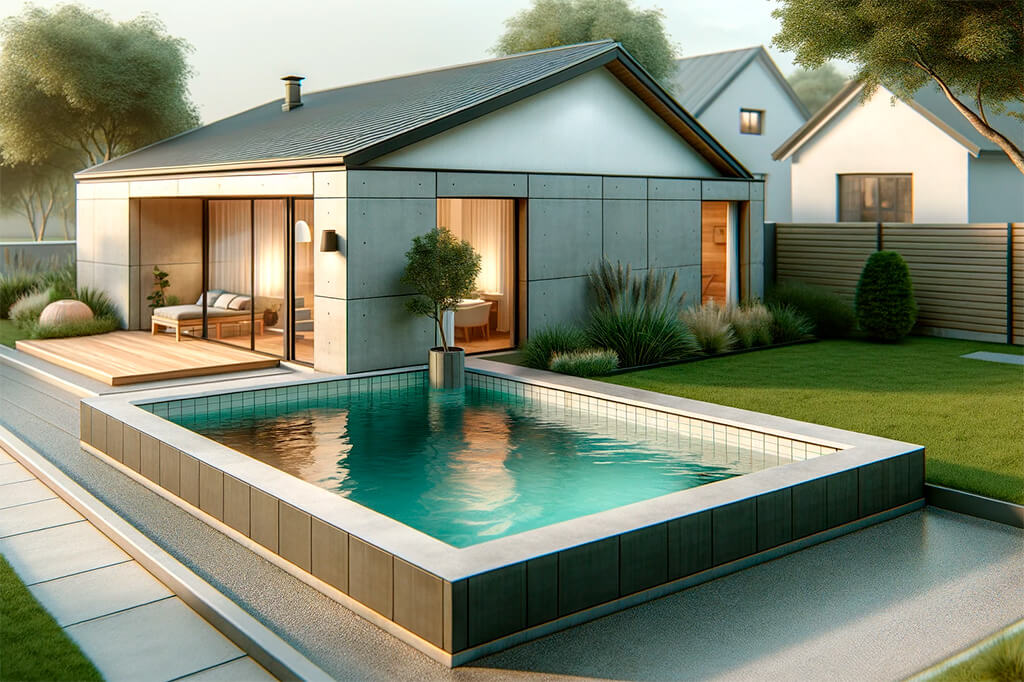In the world of pool design, coping isn’t just a trim or an afterthought. It’s the crown that sits atop your pool walls, a crucial barrier between pool and patio, and a major player in the overall look and feel of your backyard oasis. Coping is the unsung hero that keeps splashes in check and provides a sturdy grip for swimmers. Whether you’re a DIY enthusiast tackling your backyard pool project or a seasoned contractor, understanding and executing pool coping correctly is a skill worth mastering.

Understanding Pool Coping
Definition and Function: Think of pool coping as the buffer zone. It’s that critical edge around your pool, typically made of stone, concrete, or brick. It’s not just there to look pretty – it’s a functional element that directs water away from your pool and back into the drainage system, all while offering a safe, grippy edge for pool-goers.
- Stone Coping: This brings a slice of nature to your poolside. Pros: It’s robust and aesthetically versatile. Cons: Higher cost and requires sealing to prevent staining.
- Concrete Coping: If customization is your game, concrete is your player. Pros: Affordable and can be shaped and colored in countless ways. Cons: Vulnerable to cracking and chipping over time.
- Brick Coping: For a touch of traditional elegance. Pros: Durable with a classic look. Cons: Can loosen over time, requiring maintenance.
Design Considerations: Your choice in coping will influence the whole character of your pool. Rounded edges offer comfort and safety, especially for young swimmers, while the color and texture can either complement or contrast your pool and landscape.
Installation Essentials
Preparatory Steps:
- Measure Twice, Cut Once: Accurate dimensions are crucial.
- Material Matters: Consider the local climate, pool use, and aesthetic.
- Tool Time: Gather the right tools – a mortar mixer, trowels, spacers, and levels.
Step-by-Step Installation Guide:
- Start with a Clean Slate: The pool edge should be debris-free and level.
- Laying the Foundation: Apply mortar or adhesive evenly.
- Coping Placement: Begin at one end, methodically working around the pool.
- Keep it Level: Consistently check for even alignment.
- Filling the Gaps: Once in place, grout between the coping stones.
- Seal the Deal: Particularly important for porous materials like stone and brick.
Common Mistakes to Avoid:
- Battling the Elements: Don’t install in extreme weather.
- Rushing the Job: Patience is key in ensuring proper alignment.
- Skipping Sealant: This could lead to water damage or unsightly stains.
Pool Coping Ideas and Trends
In my years on various job sites, I’ve noticed a distinct shift towards natural stone in pool coping. Materials like bluestone, travertine, and slate are in vogue for their elegant appearance and durability. Another trend gaining momentum is the seamless coping style, where the coping smoothly transitions into the pool deck. This creates a unified, sleek look. For those looking for something more glamorous, glass tile coping is the way to go, adding a splash of luxury to the poolside.
For those who dare to think outside the box, there’s a world of creative possibilities in pool coping. Mixing materials, such as combining wood with stone, can create a stunning visual impact. For a more rustic aesthetic, irregular flagstone can give your pool a unique, natural look. And for a contemporary twist, consider cantilevered concrete coping. This style gives the illusion of a floating edge and can really elevate the modern appeal of your pool.
Selecting the right coping is akin to choosing the perfect accessory, it needs to match the style and shape of your pool. For traditional rectangular pools, clean-cut pavers or brick coping are ideal. For more organic, freeform pools, natural stone complements the curves beautifully. In lap pools, where functionality is key, opt for smooth, flat coping to avoid any interference with swimming.
Maintenance and Repair
Maintaining your pool coping is straightforward but crucial. Stone and concrete coping require regular sealing to prevent staining and weather damage. Brick coping may need re-pointing occasionally to keep it secure and intact. For glass tile coping, a gentle, non-abrasive cleaner will keep it looking pristine.
Dealing with wear and tear in coping is part of the game. For minor cracks in concrete coping, a quality concrete patching compound is your best friend. If stone coping becomes discolored, a thorough cleaning followed by resealing can often restore its original beauty. Loose bricks can usually be re-set with new mortar, a simple yet effective fix.
FAQ Section
Certainly. Upgrading your coping can refresh your pool’s look without the need for a complete overhaul. It’s a cost-effective way to breathe new life into your pool area.
Each material has its maintenance profile. Stone and concrete need resealing every few years to maintain their look and integrity. Brick may require some occasional re-pointing. For those seeking lower maintenance options, consider pavers or composite materials.
Yes, there are several sustainable choices. Recycled glass tiles are an eco-friendly and visually appealing option. Some manufacturers also offer coping materials made from sustainable woods or recycled plastics.
Saltwater pools can be harsh on certain materials. Opt for salt-resistant options like travertine, porcelain, or specially treated concrete to ensure longevity and maintain appearance.
If you’re working within a budget, precast concrete pavers or brick are affordable yet durable choices. It’s important to balance cost with quality to ensure that you’re not sacrificing longevity or aesthetic appeal.
